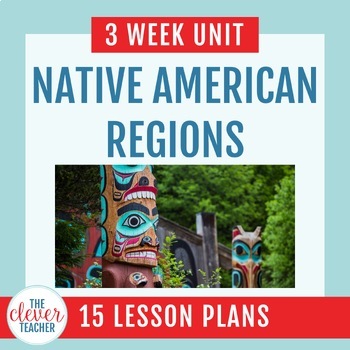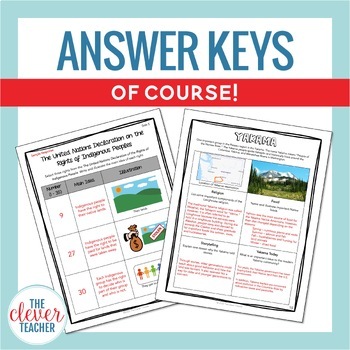Native American Regions Unit | 5th Grade – 8th Grade
- Zip
- Google Apps™

What educators are saying
Description
This Native American Regions unit covers Indigenous groups from eight cultural regions: Eastern Woodlands, Great Plains, Southwest, Pacific Northwest, Plateau, Great Basin, California, and Southeast.
I’ve made these activities about Indigenous Americans as easy as possible for busy teachers to implement. From thorough lesson plans to answer keys – it’s all there.
This history unit will help you thoughtfully teach about Native Americans’ diverse cultures. It will also prepare you to tackle complex topics like Indigenous slavery, Old World diseases, and colonization.
Even better, I’ve made it engaging! Your students will especially love the lesson where they create a presentation about one Native American group. But these aren’t simple posters or PowerPoints. Instead, students can pick from options like creating a podcast, designing a museum exhibit, writing a news broadcast, and more!
What do students learn about each region?
Over several lessons, students study the following Native American cultural regions:
- Eastern Woodlands
- Great Plains
- Southwest
- Pacific Northwest
- Plateau
- Great Basin
- California
- Southeast
For each region, students learn the following:
- The region’s environment (geography and climate)
- Important native foods
- Types of housing
- Indigenous groups that lived there
- Other cultural features (ex: societal and religious norms, tools, trading patterns, etc.)
In addition, a specific Indigenous Nation is highlighted from each region. Students learn about this group’s culture and important issues facing the group today.
The following Indigenous Nations are highlighted:
- Haudenosaunee (Iroquois)
- Lakota (Sioux)
- Navajo
- Tlingit
- Yakama
- Shoshone
- Yurok
- Cherokee
Of course, students learn about these regions in various engaging ways – from gallery walks and task cards to slideshows and student presentations. The information is never presented the same way twice in a row!
Students show what they’ve learned by creating a Cultural Atlas of Native Americans.
Here’s what’s included in the 3-week Native American Regions unit
Introduction Lessons:
- Origin of Indigenous People— Contrast Indigenous creation stories and examine scientific theories of human settlement in the Americas
- What is Culture?— Define “culture” and analyze your own identity by creating an identity chart
- Mapping Cultural Regions— Explain how geography, natural resources, and climate influence culture; label 8 Native American cultural regions on a map
8 Cultural Regions:
- Eastern Woodlands— Create Cultural Atlas pages about the Native people of the American Northeast and the Haudenosaunee (Iroquois)
- Great Plains— Create Cultural Atlas pages about the Great Plains Indigenous peoples and the Lakota (Sioux)
- Southwest— Create Cultural Atlas pages about the Southwest Indigenous peoples and the Navajo
- Pacific Northwest— Create Cultural Atlas pages about the Native people of the Pacific Northwest and the Tlingit
- Student Project— Plan a group project about a Native American group (project choices: poster, podcast, test and answer key, task cards, lap book, newscast, slideshow, or museum exhibit)
- Student Workday— Plan a group project about a Native American group
- Plateau & Yakama Presentations— Listen respectfully to student presentations and create Cultural Atlas pages about the Plateau Indigenous peoples and the Yakama
- Great Basin & Shoshone Presentations— Listen respectfully to student presentations and create Cultural Atlas pages about the Great Basin Indigenous peoples and the Shoshone
- California & Yurok Presentations— Listen respectfully to student presentations and create Cultural Atlas pages about the California Indigenous peoples and the Yurok
- Southeast & Cherokee Presentations— Listen respectfully to student presentations and create Cultural Atlas pages about the Southeast Indigenous peoples and the Cherokee
Conclusion Lessons:
- Effects of Colonization— Explain how European colonization affected Indigenous Americans in general and how it affected people in four specific cultural regions
- Indigenous People Today— Option 1: Write thoughtful questions to ask a representative of a local tribe about their culture OR Option 2: research and teach about a modern-day Indigenous American leader; illustrate three main ideas from the Declaration on the Rights of Indigenous Peoples
Native Americans Unit: Help For The Teacher
- Table of contents (also available in the preview)
- Suggested pacing guide
- 15 lesson plans
- Answer Keys (Of course!)
- Editable end-of-unit test and study guide
- Easy printing file with all student worksheets and articles
- Three complete slideshows
This Native American Regions unit also includes digital access via Google Slides.
I have created a Google Slides resource for each lesson. Each resource contains student instructions, student worksheets with editable text boxes, and articles/task cards, if applicable. Teachers can assign Google Slides via Google Classroom.
Why I created this Native American Regions unit plan
1. I want your students to love learning about U.S. history!
2. Teachers deserve excellent social studies resources (Can someone please tell our school districts?)
3. Planning complete units is tedious and time-consuming. I want to save teachers time so they can focus on doing what they love—teaching!
FAQs
How can this unit be for grades 5th-8th?
The articles are written at a 7th-8th grade reading level. If you teach one of those grades, your students will be able to complete the activities more or less independently. If you teach 5th or 6th grade, I recommend reading and analyzing the articles with your students. They will do great! Check out the reviews to see how teachers at your grade level have successfully used and loved this unit.
Where can I find more history units?
I have already created units for the following topics:
- Age of Exploration
- 13 Colonies
- Declaration of Independence
- US Constitution
- Early Republic
- Revolutionary War
- Westward Expansion
- Civil War
Customer Tips:
For samples of what is included, download the preview file. I would love to answer any and all questions about this product. Ask a question by clicking on “Product Q & A”
All of my products are digital and non-refundable. This is a digital file. A physical product will not be shipped. Please make sure you have a way to open: a zip file, PDFs, PowerPoint presentations, and a word document before purchasing.
This product is not editable. The only editable part of the unit is the end-of-unit study guide and test. The other elements (like lesson plans, student worksheets, PowerPoint presentations, Google Slides, etc.) are not. The PDFs are password protected. This protects my work and the work of graphic and font artists I've purchased from.





